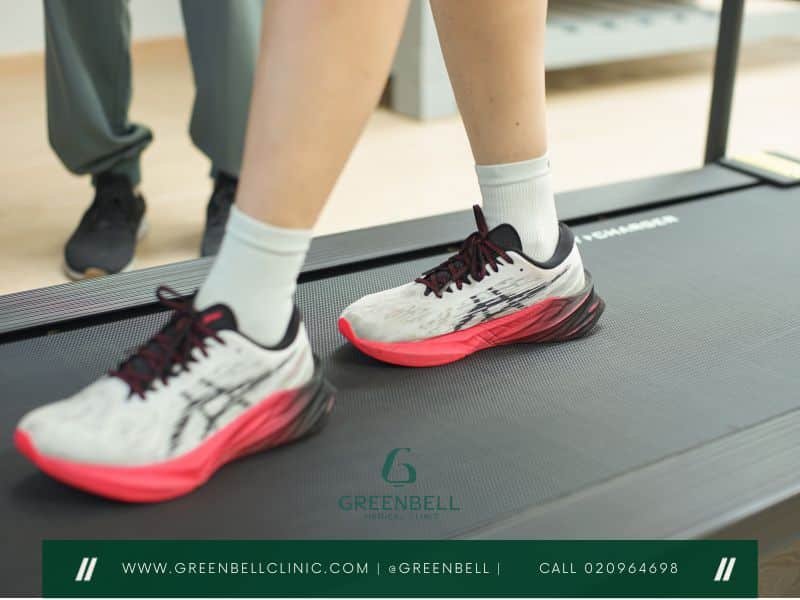Effective Exercises for Degenerate Disc Relief
Living with degenerative disc disease can be tough and frustrating. But, there is hope. The key is to take a proactive approach with a good exercise plan. This guide will show you exercises that help people with degenerate discs in Thailand.
Degenerative disc disease is a common issue where the discs in the spine break down. This leads to pain, stiffness, and less mobility. But, the right exercises can help manage symptoms and improve spinal health.

Key Takeaways
- Exercises can provide relief for individuals with degenerative disc disease
- Low-impact exercises, such as walking and swimming, can help reduce stress on the spine
- Core strengthening exercises, like planks and bridges, can support the spine and improve stability
- Spinal decompression exercises, including inversion table therapy and traction, can alleviate pressure on the discs
- It’s important to avoid high-impact exercises and consult with a physiotherapist for a personalized exercise plan

Understanding Degenerative Disc Disease
Degenerative disc disease affects the intervertebral discs, which are the cushions between the vertebrae in the spine. These discs can break down over time, causing pain, stiffness, and other symptoms. Knowing what causes and risks of this condition is key to managing and preventing it.
What is Degenerative Disc Disease?
Degenerative disc disease makes the discs in the spine lose their flexibility and shock-absorbing abilities. This can happen due to aging, injury, or certain medical conditions. As they degenerate, the discs may become thinner, crack, or tear, losing their ability to cushion the vertebrae.
Causes and Risk Factors
The main causes of degenerative disc disease are:
- Natural aging process: As we age, our spine discs lose water content and become brittle, making them more prone to damage.
- Injury or trauma: A sudden impact or repetitive stress can harm the discs, leading to degeneration.
- Genetic factors: Some people may be more likely to get degenerative disc disease because of their genes.
- Lack of physical activity: Sitting too much can weaken the muscles and ligaments around the spine, leading to disc degeneration.
- Obesity: Being overweight can put extra stress on the discs, speeding up their degeneration.
Knowing these causes and risks helps people take steps to manage and maybe prevent degenerative disc disease.
| Risk Factor | Description |
|---|---|
| Age | Degenerative disc disease is more common in older adults, as the discs naturally lose their water content and flexibility over time. |
| Injury | Sudden trauma or repetitive stress on the spine can damage the discs, leading to degeneration. |
| Genetics | Some individuals may be predisposed to degenerative disc disease due to their genetic makeup. |
| Lifestyle | A sedentary lifestyle and obesity can contribute to disc degeneration by placing additional stress on the spine. |
“Degenerative disc disease is a common condition that can have a significant impact on an individual’s quality of life. Understanding the underlying causes and risk factors is the first step in effectively managing this condition.”

Importance of Exercise for Degenerative Discs
Regular exercise is key for people with degenerative disc disease. It helps ease symptoms and boosts spine health and mobility. By knowing the importance of exercise for degenerative discs, patients can manage their condition better and live better.
Exercise strengthens muscles around the spine, which supports the vertebrae and lessens disc stress. This slows down disc degeneration and lowers the risk of more damage.
- Improves flexibility and range of motion in the spine
- Enhances blood flow, delivering essential nutrients to the discs
- Reduces inflammation and pain associated with degenerative disc disease
- Promotes weight management, which can alleviate pressure on the discs
Exercises that focus on spinal stability and decompression are great for degenerative disc disease. They strengthen the core and improve spine stability. This leads to better outcomes for those with this condition.
| Exercise Type | Benefits for Degenerative Discs |
|---|---|
| Low-impact Aerobic Exercises | Improve cardiovascular health, promote weight loss, and reduce stress on the spine |
| Stretching and Mobility Exercises | Increase flexibility and range of motion, reducing the risk of further disc degeneration |
| Core Strengthening Exercises | Enhance spinal stability and support, alleviating pressure on the discs |
Adding a balanced exercise plan to their life helps people with degenerative disc disease manage their condition. The importance of exercise for degenerative discs is huge. It’s a non-invasive way to tackle symptoms and the root causes of this condition.

Low-Impact Exercises for Degenerate Disc Relief
For people with degenerative disc disease, finding low-impact exercises is key. Walking and swimming are great options. They help with the issues of disc degeneration.
Walking and Swimming
Walking is a low-impact exercise that strengthens the core and boosts spinal health. It helps nutrients reach the discs, aiding healing. Swimming is also good for those with degenerative discs. The water’s buoyancy eases spine stress while offering a full-body workout.
Stretching Exercises
Stretching exercises for degenerative discs are also important. They improve flexibility, ease muscle tension, and lessen pain. Doing these stretches every day keeps the spine mobile and helps healing.
| Exercise | Benefits |
|---|---|
| Walking | Strengthens core, improves spinal health, encourages nutrient circulation to discs |
| Swimming | Reduces stress on the spine, provides a full-body workout |
| Stretching | Improves flexibility, reduces muscle tension, alleviates pain |
By adding these low impact exercises for degenerative discs to their routine, people with disc degeneration can better manage their condition. They can reduce pain and enhance their life quality.
Core Strengthening Exercises
Core exercises are key for those with degenerative disc disease. They help stabilize the spine and ease symptoms. Planks and bridges are two great exercises for this condition.
Planks for Disc Degeneration
Planks are easy yet effective for strengthening the core. They work on the abdominals, back, and hips. This helps support and stabilize the spine, easing the strain on degenerated discs.
To do a plank, start in a push-up position. Keep your body straight from head to heels. Hold it for 30 seconds to a minute, focus on your form, and breathe.
Bridges for Disc Degeneration
Bridges are great for strengthening the core too. They focus on the glutes, hamstrings, and lower back. These muscles support the spine.
To do a bridge, lie on your back with knees bent and feet flat. Engage your core and lift your hips off the ground. Make a straight line from knees to shoulders. Hold for 30 seconds to a minute, then slowly go back down.
Adding core strengthening exercises for disc degeneration, like planks for disc degeneration and bridges for disc degeneration, to your routine can greatly improve spinal stability. It can also reduce pain and support better disc health.

Lumbar Stabilization Exercises
Keeping your lower back strong and stable is key if you have degenerative disc disease. Lumbar stabilization exercises help strengthen muscles that support your spine. This can ease pain and lower the chance of more disc damage.
These exercises work on your core muscles, like your abs, obliques, and lower back. They help keep your spine stable and improve your posture. By making these muscles stronger, you can ease pressure on your discs. This helps you move better and lessens degenerative disc disease symptoms.
Plank Exercises
The plank is a top exercise for stabilizing your lower back. It makes your core muscles work, including the transverse abdominis, rectus abdominis, and erector spinae. These muscles help keep your spine stable and improve your posture.
- Start in a push-up position, with your hands under your shoulders and your body straight from head to heels.
- Hold this position, engaging your core muscles, for 30 seconds to 1 minute.
- Gradually increase the duration as you build strength.
Bridges
Bridges are great for strengthening your lumbar region and improving spinal stability. This exercise targets the gluteal muscles and the posterior chain, which support your lower back.
- Lie on your back with your knees bent and your feet flat on the floor.
- Lift your hips off the ground, forming a straight line from your knees to your shoulders.
- Hold the bridge position for 30 seconds to 1 minute, then lower back down.
- Repeat for 10-15 reps.
Adding lumbar stabilization exercises for disc degeneration and spinal stabilization exercises for degenerative discs to your routine can greatly improve your spinal health. It can also give you relief from degenerative disc disease symptoms.

Exercises to Avoid with Degenerative Discs
When you have degenerative disc disease, picking the right exercises is key. High-impact activities can make the condition worse. Here are some exercises to skip if you have degenerative discs:
- High-impact exercises: Running, jumping, and heavy weightlifting can be tough on the discs. They can lead to more pain and swelling.
- Extreme forward bending: Doing things like touching your toes or sit-ups can strain the discs. This can make the condition worse.
- Twisting movements: Rotational exercises, like torso twists or oblique crunches, can also be bad news. They put extra stress on the spine.
Remember, the right exercises to skip can change based on your symptoms and the severity of your condition. Talking to a healthcare professional or physical therapist can help find the best exercises for you.
“Listen to your body and avoid any movements that cause sharp pain or discomfort. The key is to find low-impact exercises that strengthen the core and improve flexibility without further damaging the discs.”
By choosing wisely and avoiding risky activities, people with degenerative disc disease can manage their symptoms. This helps them stay active and healthy.
exercises for degenerate disc
If you’re dealing with a degenerate disc, the right exercises can help. They include low-impact activities, core strengthening, and spinal decompression. These exercises can ease pain, boost mobility, and support your spine’s health.
Walking is a great exercise for degenerate discs. It improves blood flow, reduces inflammation, and helps deliver nutrients to the disc. Swimming is also good because it eases spine pressure and lets you move easily.
Strengthening your core muscles is key for spine support and easing disc pressure. Planks and bridges are good for building core strength and better spinal alignment.
Spinal decompression exercises like using an inversion table or gentle traction can also help. They relieve pressure on the disc and aid healing.
“Consistent, low-impact exercise is key for managing the symptoms of a degenerate disc. It’s important to work closely with your healthcare provider to develop a personalized exercise plan that addresses your specific needs.”
Always listen to your body and skip exercises that make things worse. With the right approach, you can manage your degenerate disc and enhance your life quality.

Pain Management Strategies
Degenerative disc disease can cause ongoing pain. But, there are ways to help manage this pain. Heat and cold therapy, along with medications and alternative therapies, can offer relief.
Heat and Cold Therapy
Using heat or cold on the affected area can ease the pain from degenerative discs. Heat therapy boosts blood flow and eases muscle tension. Cold therapy helps reduce swelling and dulls pain. These methods are easy and don’t involve surgery. They can be used with other treatments to help with disc degeneration.
Medications and Alternative Therapies
Sometimes, pain management for degenerative discs means taking medications. This could be over-the-counter anti-inflammatory drugs or prescription painkillers. Yet, many people also look into alternative therapies to go along with their treatment. These include:
- Acupuncture
- Massage therapy
- Physiotherapy
Alternative therapies for disc degeneration can offer more relief and help the body heal naturally.
“Combining multiple pain management strategies can be the key to effectively managing the discomfort associated with degenerative disc disease.”
By using both traditional and alternative methods, people with disc degeneration can find a full solution to pain management. This can greatly improve their life quality.
Lifestyle Modifications for Disc Degeneration
Managing degenerative disc disease requires a mix of actions. Improving your posture and ergonomics is key. These changes can greatly help your spinal health and slow down disc degeneration.
Posture and Ergonomics
Good posture keeps your spine’s natural curve and lessens strain on your discs. Here are some tips to help you:
- Keep your spine straight and upright when sitting, standing, or walking.
- Avoid slouching or leaning forward, which can harm your discs.
- Use furniture and tools designed for your comfort, like adjustable chairs and desks.
- Stretch and move regularly to avoid sitting or standing too long.
Making your workspace better can also help with degenerative disc disease. Make sure your desk and chair support your spine. This might mean changing your desk height, using a supportive chair, or trying a standing desk.
| Posture and Ergonomic Tips | Benefits for Degenerative Disc Disease |
|---|---|
| Maintain upright, neutral spine alignment | Reduces pressure and strain on intervertebral discs |
| Use adjustable, ergonomic furniture and equipment | Supports proper spinal positioning and reduces disc stress |
| Take regular movement breaks | Improves blood flow and nutrient delivery to discs |
By making these changes in your daily life, you can help manage your degenerative disc disease. These actions can also slow down further disc damage.
Conclusion
Managing degenerative disc disease requires a mix of exercise, pain management, and lifestyle changes. This article has shown how important it is to understand the condition and the benefits of low-impact exercises. Core strengthening and spinal decompression are also key.
It’s important to avoid high-impact activities that can make things worse. By following these tips, people in Thailand can better manage their degenerative disc disease. This can improve their quality of life.
A holistic approach that includes exercise, managing pain, and changing your lifestyle works best. Stick with your rehab plan and be patient as you get stronger over time.





